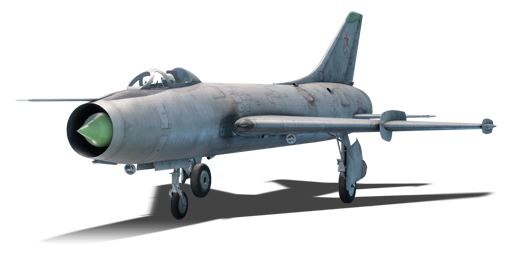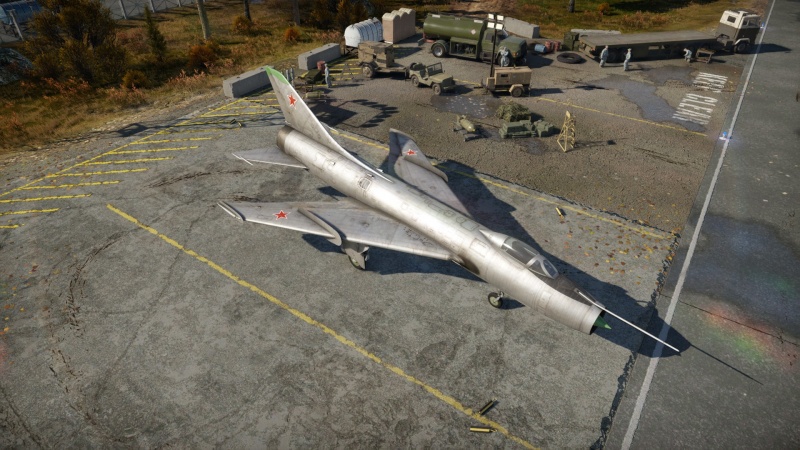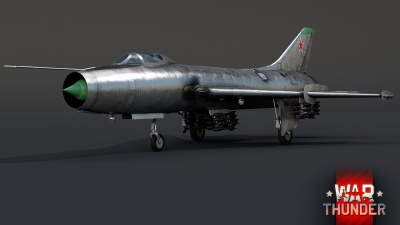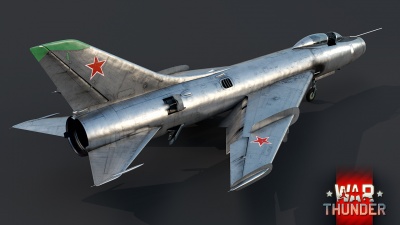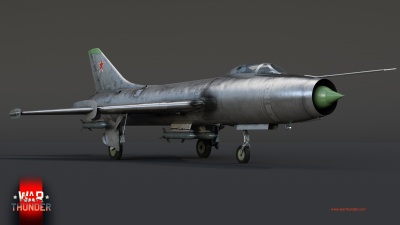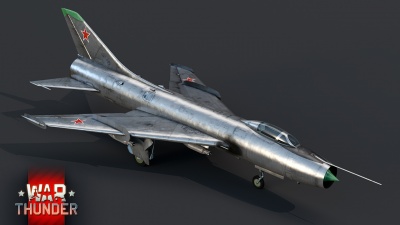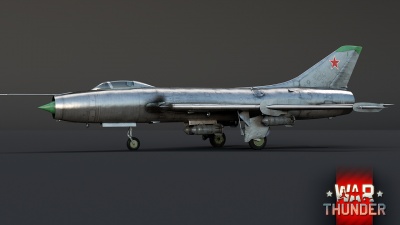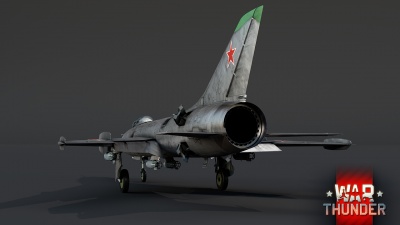Su-7B
| This page is about the Soviet strike aircraft Su-7B. For other versions, see Su-7 (Family). |
Contents
Description
The Su-7B is a rank VI Soviet strike aircraft with a battle rating of 9.3 (AB/RB) and 9.7 (SB). It was introduced in Update "Starfighters".
General info
Flight performance
The Su-7B is characterised by a low BR for a supersonic jet and amazing acceleration. With a 1-1 thrust-weight ratio when at optimal fuel load and spaded, it can reliably punch above its weight. The Sukhoi accelerates extremely well, outspeeding every supersonic at its BR except for MiG-21s. The manoeuvrability isn't bad, either - It can easily turn with supersonic aircraft such as MiG-21s, Harriers or A-7s. However, you must keep in mind that the plane has a tendency to break its wings if in a sustained 9+G turn at high speeds, and that you are not invulnerable while turning. You are giant, almost twice as big as a MiG-21, so be sure to not overstay your welcome in a dogfight and zoom away as soon as possible.
| Characteristics | Max Speed (km/h at 11,000 m) |
Max altitude (metres) |
Turn time (seconds) |
Rate of climb (metres/second) |
Take-off run (metres) | |||
|---|---|---|---|---|---|---|---|---|
| AB | RB | AB | RB | AB | RB | |||
| Stock | 2,161 | 2,145 | 19000 | 27.4 | 28.2 | 166.4 | 157.6 | 1,250 |
| Upgraded | 2,323 | 2,232 | 26.6 | 27.0 | 227.0 | 195.0 | ||
Details
| Features | |||||
|---|---|---|---|---|---|
| Combat flaps | Take-off flaps | Landing flaps | Air brakes | Arrestor gear | Drogue chute |
| X | X | ✓ | ✓ | X | ✓ |
| Limits | ||||||
|---|---|---|---|---|---|---|
| Wings (km/h) | Gear (km/h) | Flaps (km/h) | Max Static G | |||
| Combat | Take-off | Landing | + | - | ||
| 0 | 630 | N/A | N/A | 473 | ~11 | ~3 |
| Optimal velocities (km/h) | |||
|---|---|---|---|
| Ailerons | Rudder | Elevators | Radiator |
| < 700 | < 650 | < 600 | N/A |
Engine performance
| Engine | Aircraft mass | |||||
|---|---|---|---|---|---|---|
| Engine name | Number | Basic Mass | Wing loading (full fuel) | |||
| Saturn AL-7F-1-100 | 1 | 7,926 kg | 315 kg/m2 | |||
| Engine characteristics | Mass with fuel (no weapons load) | Max Takeoff Weight | ||||
| Weight (each) | Type | 8m fuel | 20m fuel | 27m fuel | ||
| 2,200 kg | Afterburning axial-flow turbojet | 8,756 kg | 10,000 kg | 10,726 kg | 13,043 kg | |
| Maximum engine thrust @ 0 m (RB / SB) | Thrust to weight ratio @ 0 m (WEP) | |||||
| Condition | 100% | WEP | 8m fuel | 20m fuel | 27m fuel | MTOW |
| Stationary | 5,848 kgf | 8,257 kgf | 0.94 | 0.83 | 0.77 | 0.63 |
| Optimal | 6,664 kgf (1,000 km/h) |
9,974 kgf (1,000 km/h) |
1.14 | 1.00 | 0.93 | 0.76 |
Survivability and armour
- 20 mm Aluminium Alloy - pilot's headrest
- 36 mm Aluminium Alloy - pilot's backrest
- 8 mm steel - cockpit front bulkhead
- 102 mm Bulletproof glass - Armoured windscreen
Modifications and economy
Armaments
| Ballistic Computer | |||
|---|---|---|---|
| CCIP (Guns) | CCIP (Rockets) | CCIP (Bombs) | CCRP (Bombs) |
| |
|
|
|
Offensive armament
The Su-7B is armed with:
- 2 x 30 mm NR-30 cannons, wing-mounted (80 rpg = 160 total)
Suspended armament
The Su-7B can be outfitted with the following ordnance:
- Without load
- 64 x S-5K rockets
- 4 x S-24 rockets
- 28 x S-3K rockets
- 4 x 250 kg OFAB-250sv bombs (1,000 kg total)
- 4 x 500 kg FAB-500M-54 bombs (2,000 kg total)
Usage in battles
Build and maintain speed. Go for slow enemies and make sure to conserve your ammunition. A skilled pilot can easily get 3 to 4 kills with the 160 rounds of NR-30 ammo provided, but an unskilled pilot will have trouble hitting their shots. NR-30 cannons are (arguably) the best jet cannons one can have, and even a single hit can devastate an opponent. In conclusion, the Su-7B is a great plane, with amazing cannons and even better performance. Opponents will often underestimate you or even try to dogfight you.
Radars
The Su-7B is equipped with a SRD-5 rangefinding radar, located in the nose of the aircraft. It will automatically detect other planes within the scanning area and display the range to the closest target. It is linked with a gyro gunsight and can help with aiming at close range.
| SRD-5 - Rangefinding radar | |||
|---|---|---|---|
| Maximum Tracking Range |
Minimum Tracking Range |
Azimuth Tracking Angle |
Elevation Tracking Angle |
| 3,000 m | 300 m | ±9° | ±9° |
Pros and cons
Pros:
- One of the fastest planes at its battle rating
- Very fast acceleration
- 2x 30 mm cannons are very powerful against ground and air targets alike
- Decent energy retention
- Time-fuzed S-24 rockets can be useful in head-ons
Cons:
- Large silhouette, easy to hit
- NR-30 cannons depletes ammunition quickly
- S-24 as anti-air are situational, unlike conventional IR missiles
- No countermeasures
History
On May 14th 1953, shortly after Stalin's death and the reopening of the Sukhoi OKB, they began work on a swept-wing front-line fighter. Their first prototype was named S-1 and was fitted with the all-new Lyulka AL-7 turbojet. It was the first Soviet aircraft to utilize the all-moving tailplane and a translating centerbody, plus a dramatic wing sweep of 60°, irreversible hydraulically boosted controls, and an ejection seat of Sukhoi's own design. After the success of the S-1, production began with the S-2. later renamed the Su-7.
Later, on 31 July 1958, the Soviet Tactical Aviation tasked Sukhoi with developing a ground-attack variant of the Su-7, which could replace the scrapped Ilyushin IL-10. The resulting prototype, S-22, incorporated structural refinements for high-speed, low-altitude operations. It first flew in March 1959 and entered service in 1961 as the Su-7B.
Devblog
With the development of jet aviation, piston-engined attack aircraft quickly became an anachronism; a need arose for a new class of front-line aircraft - a fighter bomber. In the USSR, the MiG-15 and MiG-17 fighter jets were used to replace the piston-engined IL-10 to support the ground forces from the air, but it was quite obvious that a specialized machine was needed to fulfill the tasks of the fighter-bomber. The most suitable candidate was the Sukhoi Su-7 fighter jet, taken as the basis for the Su-7B fighter-bomber project. By the end of 1958, the first prototype was ready with the new AL-7F-1 engine. For almost two years, the aircraft underwent intensive testing and refinement, and in 1960 the new fighter-bomber went into mass production. Of the 431 planned, 344 Su-7Bs were built to equip up to 25 combat units. From the beginning of the 70’s, the Su-7B aircraft began to be replaced with more modern modifications and models.
Media
- Skins
- Images
- Videos
See also
Links to the articles on the War Thunder Wiki that you think will be useful for the reader, for example:
- reference to the series of the aircraft;
- links to approximate analogues of other nations and research trees.
External links
- [Devblog] Su-7B: new doctrine
- Official data sheet - more details about the performance
- [Special] Su-7B military pilot interview
| Sukhoi Design Bureau (Сухого Опытное конструкторское бюро) | |
|---|---|
| Jet fighters | Su-9 · Su-11 |
| Su-27 | Su-27 · Su-27SM |
| Strike aircraft | |
| Su-2 | BB-1 · Su-2 (M-82) · Su-2 MV-5 · Su-2 TSS-1 |
| Su-6 | Su-6 · Su-6 (AM-42) · Su-6 (M-71F) |
| Su-7 | Su-7B · Su-7BKL · Su-7BMK |
| Su-8 | Su-8 |
| Su-17 | Su-17M2 · Su-17M4 · Su-22M3 |
| Su-24 | Su-24M |
| Su-25 | Su-25 · Su-25BM · Su-25K · Su-25T · Su-25SM3 · Su-39 |
| Su-34 | Su-34 |
| Export | ◊Su-22UM3K · ◔Su-22M3 · ◊Su-22M4 · ◄Su-22M4 WTD61 |
| J-11* | |
| *CKD and SKD kits assembled by Shenyang Aircraft Corporation | |
| USSR jet aircraft | |
|---|---|
| Bereznyak-Isayev | BI |
| Yakovlev | Yak-15 · Yak-15P · Yak-17 · Yak-23 · Yak-28B · Yak-30D · Yak-38 · Yak-38M · Yak-141 |
| Mikoyan-Gurevich | MiG-9 · MiG-9 (l) · MiG-15 · MiG-15bis · MiG-15bis ISh · MiG-17 · MiG-17AS · MiG-19PT |
| MiG-21F-13 · MiG-21PFM · MiG-21S (R-13-300) · MiG-21SMT · MiG-21bis | |
| MiG-23M · MiG-23ML · MiG-23MLD · MiG-27M · MiG-27K | |
| MiG-29 · MiG-29SMT | |
| Lavochkin | La-174 · La-15 · La-200 |
| Sukhoi | Su-9 · Su-11 |
| Su-7B · Su-7BKL · Su-7BMK · Su-17M2 · Su-17M4 · Su-22M3 | |
| Su-24M | |
| Su-25 · Su-25BM · Su-25K · Su-25T · Su-25SM3 · Su-39 | |
| Su-27 · Su-27SM | |
| Su-34 | |
| Ilyushin | IL-28 · IL-28Sh |
| Tupolev | Tu-14T |


